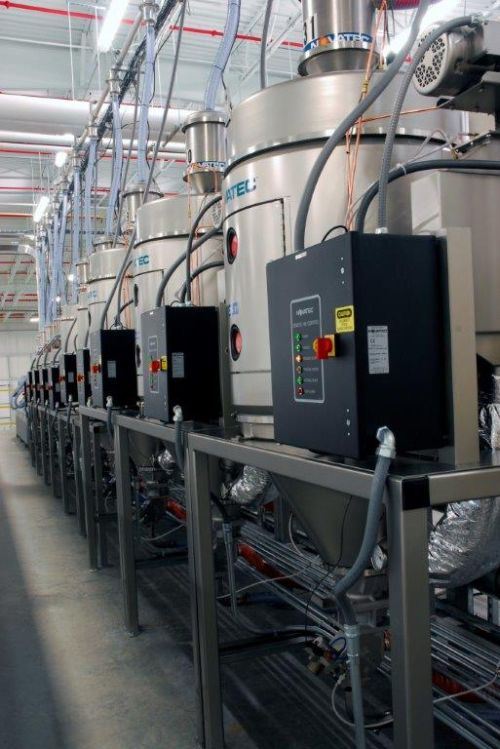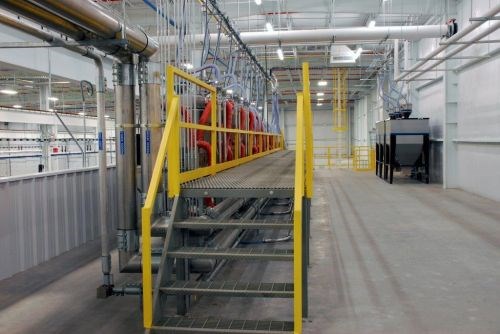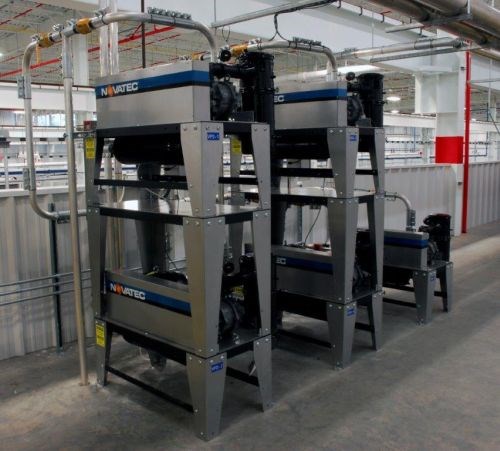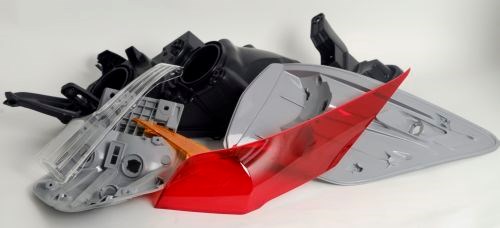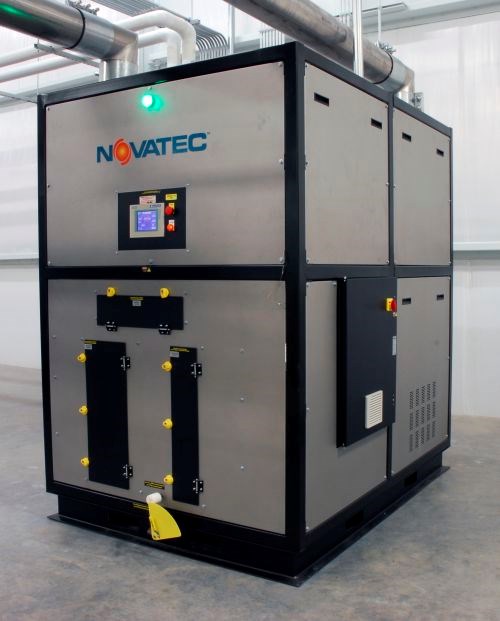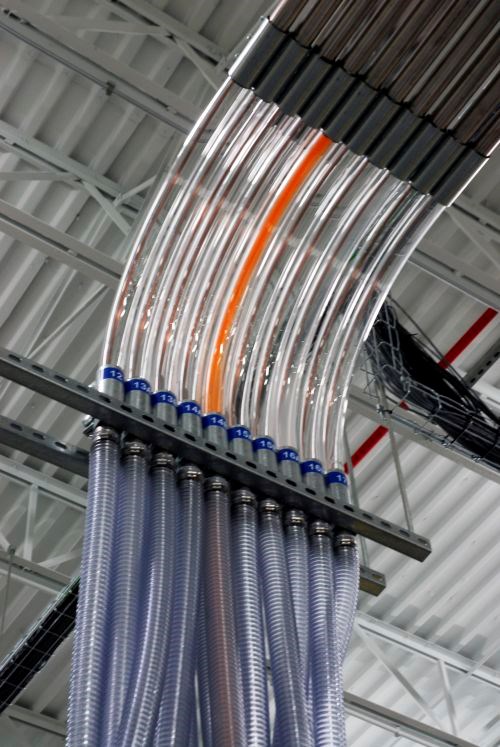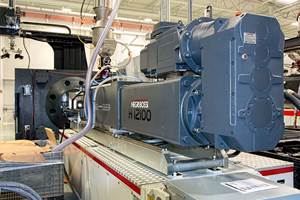Automotive molder seeks flexible solution for diverse drying needs
Clear, amber or red; headlights, taillights and turn signals: those are just some of the constantly changing jobs that custom automotive molder TASUS pulls in and out of its presses, requiring a flexible drying system to handle the ever-changing run list.
“Permanently temporary” is how Robbie Elliott describes the flow of jobs through automotive supplier TASUS’s new $8 million 104,000 square-foot injection molding facility in Florence, Ala. Elliott, director of technical development wholly-owned subsidiary of Japan-based Tsuchiya Company Limited, said that constant flux on the shop floor meant the company needed a flexible material drying and handling set up.
“We are a custom molder so everything is subject to change at a moment's notice,” Elliott noted. Flexibility to adjust to that ever-shifting work load, along with what Elliott called “user friendly software”, were the two aspects of Novatec’s drying and handling equipment that won the Maryland based company the bid to supply the growing automotive molder.
The installed Novatec equipment includes a NW-1600 NovaWheel Central Dryer, five 10-hp vacuum pumps with Cyclone dust collectors; three surge bins; and numerous portable bulk bins.
Elliott said Novatec’s equipment allows the company to drop in another drying hopper, of any size, anywhere in its line, as well as adjust the level in any hopper for smaller batch runs. The company oversized the dryers it purchased from Novatec in anticipation of future growth.
TASUS is currently running 10 Nissei hybrid X-pump injection molding machines, ranging in clamp force from 280 to 1300 metric tons. Elliott said the plan is to install several more machines in 2014, with the facility able to accommodate 30 to 40 presses, depending on future demands and other processes that might be added. “There is also an expansion already designed for future growth,” Elliott said.
The company plans to add insert molding and secondary assembly and processes. At its facilities in Indiana and Texas, it offers welding, leak testing, in-mold decorating, hot stamping, pad printing, profile extrusion, and extrusion blow molding, capabilities that Elliott could see TASUS adding to its new Alabama site.
The Florence facility is currently producing several different automotive lighting components, ranging from clear, amber, and red lenses to headlight, taillight, and turn signal housings. Elliott said the company is also molding duct work for automotive interior seating applications, as well as an air-filtration component, with “many others in the works.”
The challenge of lens materials
Because TASUS is running clear lens materials, the company decided to utilize stainless lines rather than aluminum to reduce contamination, according to Elliott. “Some of our materials are abrasive,” Elliott said. “This causes elbows to wear, so we decided to go with glass elbows to minimize this problem.”
TASUS had purge valves installed on long pellet runs, as well as pocket valves on the drying hoppers, boosting access to material inline. In addition to loading from the drying hoppers, Elliott said the company can also pull resin from silos/surge bins or gaylords. The addition of an unloading station also allows unused materials in dryers to be unloaded back into a box or bin during material changes.
Big(ger) plans
“We have laid out a plan for growth, reserving floor and overhead space for future equipment,” Elliott said. “The building plans show future drying, chilling and compressed air equipment in place, so when we do add more molding equipment the auxiliary equipment will be plug and play.”
Control of the existing and any additional Novatec auxiliary equipment is also mobile. Calling Novatec’s software “easy to understand and follow,” Elliott noted that the screens can be viewed on the plant’s local network or remotely using a tablet or smart phone. “That’s very helpful when setting up or trouble shooting,” Elliott said.
Kevin Embury, VP engineered systems business development, spent a few months working with Elliott and TASUS on shortfalls encountered in previous drying systems and seeing how and where Novatec could improve performance, particularly with regards to controls.
Key for TASUS according to Embury was the connectivity of Novatec’s conveying control system, which allows it to be hooked into the plant’s network. Also appealing was the fact that the FXS control platform is expandable, with options automatically built into the PLC based controller without the need to purchase optional upgrades.
The FXS control also allows TASUS to view its silos in “real time,” according to Embury, continuously tracking resin inventory. Thanks to the wireless and remote networking, that silo status can be viewed anywhere via smart phones, tablets, and computers.
Embury explained that since properly dried resin is critical to the success of TASUS’s molding process, the OFX Drying Hopper Control System’s ability to display the actual dew point in each of the drying hoppers in real time, further increased the attractiveness of the Novatec system. Those OFX controls network into the FXS, allowing both control panels to be shared and process monitoring to occur from either panel.
In the Florence plant’s dryer system layout, the OFX Control was located upstairs in the drying area, while the FXS was positioned downstairs, where the operators would be setting up the material distribution. “Being able to use either panel to control and monitor the entire system simplifies their daily duties,” Embury explained.
Related Content
Word Games: What’s a ‘Hybrid’?
Any molder will tell you there’s a difference in working with electric vs. hydraulic drives. Servohydraulic is still hydraulic; a hybrid machine is something different. Imprecise use of terms causes needless confusion.
Read MoreConsistent Shots for Consistent Shots
An integral supplier in the effort to fast-track COVID-19 vaccine deployment, Retractable Technologies turned to Arburg and its PressurePilot technology to help deliver more than 500 million syringes during the pandemic.
Read MoreSlimmer All-Electric Press Debuts
A slimmed-down version of Engel’s all-electric, e-mac injection molding machine is among eight displays, which also include LSR micromolding, quick mold changes and a cube mold.
Read MoreInjection Compression Molding as Alternative to Thermoforming
Arburg will show its all-electric Allrounder 720 A press utilizing injection compression molding to create thin-wall IML cups from PP.
Read MoreRead Next
Advanced Recycling: Beyond Pyrolysis
Consumer-product brand owners increasingly see advanced chemical recycling as a necessary complement to mechanical recycling if they are to meet ambitious goals for a circular economy in the next decade. Dozens of technology providers are developing new technologies to overcome the limitations of existing pyrolysis methods and to commercialize various alternative approaches to chemical recycling of plastics.
Read MorePeople 4.0 – How to Get Buy-In from Your Staff for Industry 4.0 Systems
Implementing a production monitoring system as the foundation of a ‘smart factory’ is about integrating people with new technology as much as it is about integrating machines and computers. Here are tips from a company that has gone through the process.
Read MoreHow Polymer Melts in Single-Screw Extruders
Understanding how polymer melts in a single-screw extruder could help you optimize your screw design to eliminate defect-causing solid polymer fragments.
Read More

